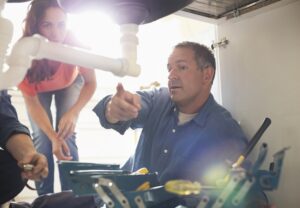Plumbing emergencies can strike at the most inconvenient times, transforming a peaceful evening into a stressful scramble. A burst pipe, overflowing toilet, or major leak can cause significant water damage and leave you feeling overwhelmed.
But fear not! By following these five steps, you can take control of the situation and minimize the damage. Just make sure to call a plumber in Plano if you need support.
1. Act Fast: Stop the Water Flow
Time is of the essence in a plumbing emergency. The quicker you stop the water flow, the less damage you’ll have to deal with later. Here’s what to do:
- Identify the source: Locate the source of the leak. Is it a burst pipe under the sink, a faulty washing machine hose, or a cracked toilet supply line? Knowing the source will help you determine the best course of action.
- Shut off the water supply: Most homes have a main water shut-off valve, typically located near the front of the house by the street or curb. Locate it beforehand if you haven’t already. Turn the valve clockwise with a wrench or pliers until you feel resistance – that signifies the water supply is off.
- For specific fixtures: If the leak is isolated to a specific fixture like a sink or toilet, there might be a shut-off valve located beneath the fixture itself. Shutting this valve will stop water flow to that specific appliance.
2. Assess the Damage and Contain the Leak
Once the water flow is stopped, assess the damage. Take pictures or videos of the leak and the surrounding area for insurance purposes. Now, it’s time to contain the leak and prevent further water damage:
- Contain the overflow: For overflowing toilets, place towels or a large pan at the base to absorb excess water. Stuff towels or rags around leaky pipes to contain the escaping water as much as possible.
- Move valuables: If the leak is near furniture or electronics, move them to a safe, dry location to prevent water damage.
- Cover floors: Cover floors with towels or plastic sheeting to prevent water from spreading and soaking into carpets or wooden flooring.
3. Address Minor Leaks (Optional):
For very minor leaks, like a dripping faucet or a loose hose connection, you might be able to address the issue yourself before calling a plumber.
- Tighten loose connections: Use a wrench to tighten any loose connections around hoses or fittings.
- Replace a worn faucet washer: If the leak is coming from the faucet handle itself, you might be able to replace a worn washer to stop the drip.
However, for major leaks, burst pipes, or any situation where you’re unsure about the cause, it’s crucial to call a professional plumber immediately.
4. Call a Licensed Plumber
Don’t attempt to tackle major plumbing emergencies yourself. Licensed plumbers have the expertise and tools to diagnose the problem, repair the leak, and ensure everything functions correctly. When calling a plumber, explain the situation clearly, including the location and severity of the leak.
5. Take Preventative Measures (After the Crisis)
Once the crisis is averted, take some preventative measures to minimize the risk of future plumbing emergencies:
- Schedule regular maintenance: Having your plumbing system inspected by a professional plumber annually can help identify potential problems before they escalate.
- Address minor issues promptly: Don’t ignore minor leaks or drips. Fixing them promptly can save you from a bigger headache (and expense) down the road.
Get it done right… Right now! Contact the experts at Hutchins Plumbing & Air Conditioning for your next emergency plumbing repair.










